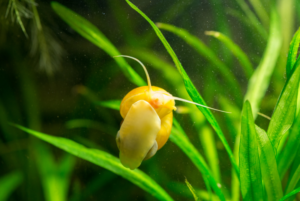Aquariums are often seen as tranquil havens, filled with various fish swimming in beautifully crafted ecosystems. However, a silent killer lurks within these picturesque settings – fish TB. This leaves aquarium owners and fish enthusiasts alike wondering – can snails get Fish TB?
Snails cannot get fish TB, but they can be parasitic hosts for the bacteria that cause fish TB. Although they are not the primary carriers, the risk of transmission of fish TB to humans is typically low unless there is direct contact with infected fish or contaminated water.
Fish TB is a silent killer that can wipe out an entire tank of fish, and what’s even more alarming is that it’s resistant to antibiotics, making it even more challenging to treat. Let’s explore this fascinating topic and determine if these little slimy creatures are at risk.
Snail-Borne Parasitic Diseases: How Snails Can Transmit Illnesses
Snails, while often seen as harmless creatures, can actually carry various illnesses that can be transmitted to humans. These illnesses are known as Snail-Borne Parasitic Diseases (SBPDs).
Millions of people living in snail-friendly climates have reportedly suffered from them. This is because snails can serve as intermediate hosts and transmission vectors for different parasites.
In 2003, researchers from the United States Geological Survey discovered a new snail species called the red-rimmed Melania snail in Biscayne National Park, Florida.
While discovering a new species is typically a cause for celebration, concerns arose about the snail’s presence in areas frequented by people. This is because the red-rimmed Melania snail can potentially transmit liver flukes, which can cause illness in humans.
Scientists have since provided ample evidence to show that snails are a part of the complex life cycle of several parasites.
Moreover, they have found that humans, snails, and crustaceans can continue the life cycle of these parasites when they ingest raw or undercooked crabs or fish.
Learn about the common myths and misconceptions surrounding snails and warts in this informative article.
Infectious Diseases in Fish: How Do Fish Get Infected with Diseases?
You’ve set up your aquarium, complete with clean water and a few snails, to keep it tidy. You sit back and relax, expecting your fish to thrive in their new home.
- But what if they get sick?
- What causes fish diseases, and how do they become infected?
Fish diseases can be caused by various pathogens, including:
- Viruses
- Unicellular algae
- Fungi
- Bacteria
While it may seem like a mystery how fish in aquariums come into contact with these pathogens, it’s worth remembering that the snails you added to the tank can actually be a source of infection.
In fact, there are two primary sources of infections and diseases in aquarium fish. The first source is the aquarium itself.
Even seemingly healthy fish can become carriers of disease-causing germs under certain conditions. This can happen when pathogens are introduced into the water, which can come from:
- The fish themselves.
- Their food.
- From contaminated equipment.
The second source of infection and diseases in aquarium fish is outside the tank. When changing the water, it’s possible to introduce contaminated water, which can then infect the fish.
Fish handlers can also introduce pathogens from the following:
- Contaminated silt.
- Equipment.
- Fish feeds.
Can Snails Carry Fish Diseases?
Snails can carry fish diseases; they can act as hosts for pathogens causing the diseases and play a vital role in their life cycle.
It’s not surprising that snails are vulnerable to pathogens, as they can ingest pathogen-infected substances, such as waste from other animals like fish, during feeding. This waste often contains pathogen eggs that hatch inside the snails. The larvae then excrete into their environment when they’re ready.
Pathogens can also enter snails through their respiratory pores and body walls when mature enough to cause diseases. When the larvae are ready to be released, snails will shed them into the water, posing a risk to humans who come into contact with contaminated water.
Fish TB is one of the diseases that humans can get infected with through contaminated water. Bathing or swimming in contaminated water can lead to penetration of the parasites through the skin.
This disease is particularly dangerous since it’s resistant to antibiotics. Therefore, prevention is crucial to avoid the transmission of pathogens from snails to humans and their pets.
Different Ways You Can Get TB From Aquarium Fish
Fish TB is caused by the Mycobacterium genus, which is highly contagious and does not respond to medications. This explains why fish die in large numbers after getting infected.
Unfortunately, the dangerous disease can spread from the fish to the owner when fish handling is done recklessly. It is human nature to try and save our dying fish, but it is important to note that we can easily get infected by the same disease that kills them.
Here are some different ways you can get TB from aquarium fish:
- Handling fish without protective gear: Catfish, for example, have sharp spines that can prick your arms if you handle them without protective gear. A small nip from a fish infected with TB is enough to transfer the illness into your system.
- Inhaling bacteria: TB bacteria can be released into the air when you clean your aquarium. Inhaling these bacteria can cause infection.
- Drinking contaminated water: If you accidentally swallow water from your aquarium, you can also get infected.
Fish TB in humans manifests in different ways, including:
- Systematic diseases: develop in persons with compromised immunities.
- Skin lesions: that develop between 3 and 9 weeks. They appear on the hands and other extreme ends where the skin is likely to be broken.
- Deep skin lesions: on rare occasions, some people have reported deep skin lesions in the muscles and tendons.
It is important to note that different Mycobacterium strains cause different symptoms in humans. The different species of the bacterium also contribute to the challenges in formulating effective treatment for the illness.
On many occasions, fish will show symptoms associated with other fish illnesses. It is important to observe your fish’s behavior closely and seek veterinary help if you notice any unusual behavior or symptoms.
What to Do With Infected Fish
Dealing with infected fish can be a heartbreaking experience for aquarists. Unfortunately, Fish TB is one of the most difficult diseases to treat, and very few options are available to save the lives of infected fish.
Once a fish has been diagnosed with Fish TB, it’s usually a matter of time before it succumbs to the illness. Many experts recommend euthanasia as the most humane option to reduce the animal’s suffering.
Although it can be difficult, it’s important to remember that allowing the fish to suffer can be crueler in the long run. Fish with Fish TB usually take a long time to die, after all their organs fail or when they finally starve.
Euthanasia can be a way to end their pain and suffering more quickly and peacefully.
Conclusion
Fish TB is a serious illness that demands the attention of any aquarist. By understanding more about this disease, you can potentially save the life of your fish and yourself.
Snails have been coexisting with fish for a long time. Many aquarists consider them a clever addition to the aquarium environment. Snails serve as natural cleaners in the tank, consuming food remnants and other waste materials.
However, there is a downside to having snails in your fish tank. These snails can spread diseases to the fish, which can then spread the disease to humans.
To reduce the chances of fish tuberculosis, it may be necessary to eliminate snails from your fish tank altogether.
Frequently Asked Questions
Can snails carry fish diseases?
Snails can act as intermediate hosts for various fish parasites, including trematodes and nematodes, which can cause diseases in fish. These parasites can be transmitted to fish when they consume snails or snail-infested food.
Can shrimp get fish tuberculosis?
Shrimp can contract fish tuberculosis caused by the bacterium Mycobacterium marinum. The disease can be transmitted to shrimp through contaminated water or infected fish. Typical symptoms include lethargy, loss of appetite, and discoloration or lesions on the shell.
Can I get TB from my fish?
It’s unlikely for humans to contract tuberculosis from their fish. Although Mycobacterium marinum, the bacterium that causes fish tuberculosis, can infect humans, it is generally considered a rare occurrence. The bacteria typically enter the body through open wounds or cuts, so practicing good hygiene and wearing gloves while handling fish can help reduce the risk of infection.
How do I know if my fish has TB?
Some signs to look for include lethargy, loss of appetite, weight loss, and external lesions. A veterinarian or fish health specialist may be able to help diagnose and treat the disease. Unfortunately, there is no cure for fish tuberculosis, and infected fish may need to be euthanized to prevent the spread of the disease to other fish.
How do you treat fish TB in humans?
Fish TB can infect humans through open wounds or cuts, leading to skin lesions and swollen lymph nodes. Treatment typically involves prolonged antibiotics, such as clarithromycin or rifampin. In severe cases, surgery may be necessary to remove infected tissue.
Sources
- PetKeen: Fish Tuberculosis (TB): Complete Guide
- BMC: Snail-Borne Parasitic Diseases: An Update on Global Epidemiological Distribution, Transmission Interruption and Control Methods
- FAO: Main Fish Diseases and Their Control
- USGS: Red-Rimmed Melania (Melanoides Tuberculatus) – A Snail in Biscayne National Park, Florida – Harmful Invader or Just a Nuisance?



